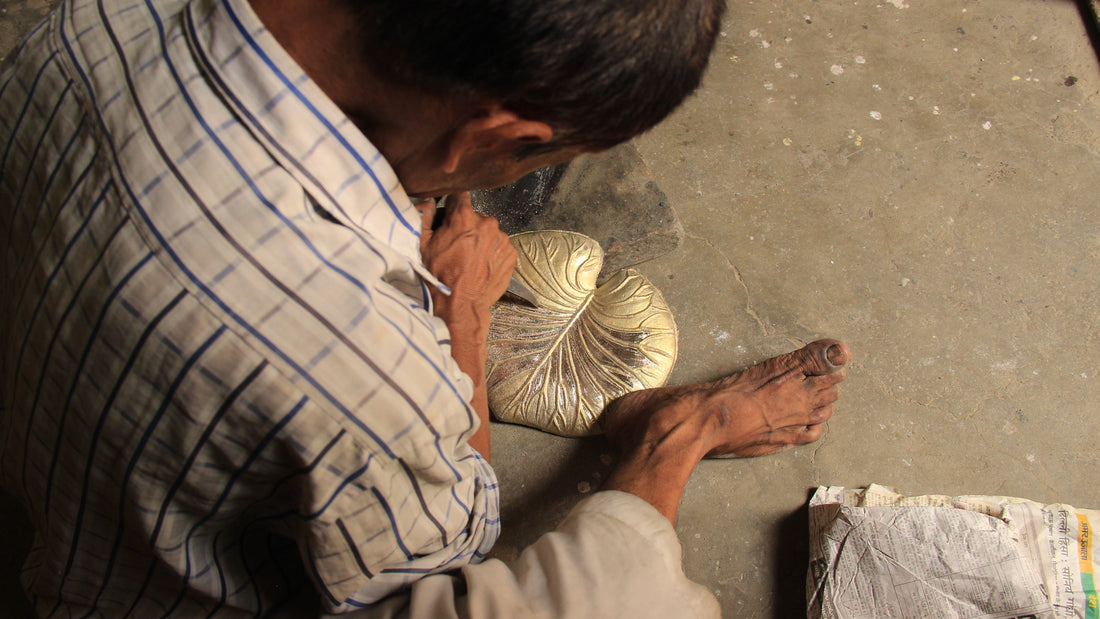Sartaj ji is one of our partners in Brasswork, Copperwork
His Inspiration
As an artisan, I believe that ‘mother nature is an endless treasury of inspiration as it is constantly changing while maintaining the pristine balance of the earth. I consider myself fortunate enough to be able to utilize the same and bring beautiful natural elements to life, through my craft. The products I design, always, therefore have a part of nature and of course, a part of my heart incorporated within.
TICP x Sartaj
Catalyst 2030 Award Designed by The India Craft Project
The first award that I have created is the ‘Padmapatra’ (Sanskrit literary roots, in which, the Padma means Lotus, and Patra means Leaf). As the name suggests, Padmapatra is a lotus leaf supported by a brass stem and mounted on a raised brass platform. The mounting platform has customized etching on it and is packed in a beautiful black velvet box which accentuates its golden hue. The second award I designed is the ‘Dokra Vyadh-Patang’ (Hindi literary roots where Vyadh patang refers to a dragonfly), which is a diagonally inclined ‘Dokra’ dragonfly.
Medium and Material Used In Production
For my artifacts, I have used recycled brass that is obtained from old rails from railway tracks, that are unused and left to be worn out. This is a little effort from my end in ensuring sustainability and environmentally-friendly changes in the artisanal industry.
What do the design (elements) signify?
Metamorphosis is the process of holistic transformation that can bring a renaissance to existing structures. It signifies the advent of a positive and uplifting change. A lotus leaf floats in muddy bogs. Nevertheless, it can stay pristine and untouched by the dirt. The ‘Padmapatra’, my first award signifies that the key to happiness in life is to stay in the bog of superficial worldliness and the dynamic world, yet remain untouched by its complexities. On the other hand, my second work, the ‘Dokra Vyadh-Patang’ is a symbol of positive metamorphosis. The dragonflies have to undergo several moultings to become beautiful flying organisms. Similarly, at every stage of life, adaptability to the circumstances and molding oneself accordingly sets a person free of negative emotional bondages.
Fabrication Process
The unused and old rails are molten into bricks. These bricks are then again molten on coal furnaces and put on dice molds with pre-formed patterns. When the metal cools down, the dice are separated and the artefact is obtained.
Background
I have learned Brass Work from my ‘nanaji’(grandfather). He had a craft shop in the Purani Delhi area by the name of ‘India Craft Emporium’. More than 20 artisans worked under his supervision and he was known for his mastery of the skill. I was fortunate enough to have him as my ‘Guru’(Teacher), and live with him for a long time to learn the craft. When I started my business, there were a few hiccups in resolving financial capital, interference of middlemen, lack of worthy returns, and additional costs. Despite the struggles, I was able to stand unshakable. Today, many craftsmen work under my supervision as well! Working in this field for several decades, I can say that the essence of brass work and copper work has maintained their essence and aura. I want to inculcate the same love for this beautiful craft in my daughter so that this artisanal legacy is carried forward.
